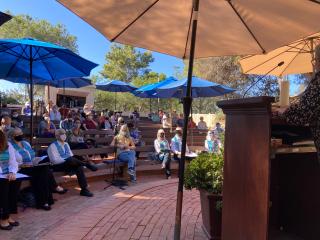January 2022 Letter
Dear Congregational Leaders,
Throughout this pandemic, we all have worked to understand how to make decisions about what is risky and what is safer. We have often relied on metrics, especially case numbers and test positivity. The example policies and Delta guidance we’ve featured on UUA.org have pointed to metrics such as local case rates or test positivity rates compiled by organizations such as COVID Act Now.
To better meet this current moment, we will be retiring our previous guidance for congregations that focused on metrics and instead will present up-to-date strategies that can mitigate risk when meeting in person. To be clear, these strategies will not provide concrete guidance on when to meet in person. This decision is increasingly specific and local: not only specific to one’s city and county, but also specific to the congregation’s people, building size, and ventilation systems.
As many congregations have relied on the same metrics, we want to explain why we are making this change and what local data congregations might track instead when deciding about meeting in person:
- We are now at a time in the pandemic when the case numbers are no longer a reliable indication of actual infection rates in a community. The rising use of rapid tests, whose results are not reported to cities and counties, means that the actual number of infected persons in each community is much higher than the official case rate derived from PCR tests.
- As well, we are at a time when COVID case numbers are not a measurement of risk of severe outcomes for many. Vaccinations continue to protect against severe outcomes for those age five and up. Further, following the Delta and Omicron waves, many adults and children will have some immunity from previous infections.
- While it’s impossible to predict now if there will be surges of new variants, our near term future looks more like a bumpy transition towards an endemic. In an endemic, local risk will vary significantly based on local outbreaks; it will be difficult for the UUA to give guidance from a national level.
As Unitarian Universalists, we want to balance our priorities including: supporting those most at risk if exposed to COVID-19, meeting our communities’ mental and emotional needs (especially after almost two years of an isolating pandemic), and tending to the well-being of our larger communities’ institutions such as hospitals and schools.
As we move out of the current Omicron surge, we know that “in-person” will be different in each congregation. We assume congregations will strive for both in-person and online participation, even if at different times and different ways, to meet the needs of those who cannot risk a COVID-19 infection.
With the sky-high infection levels of the Omicron surge and its impact on our health care system, many congregations returned to a mostly online congregational life and are wondering when to return to multiplatform Sunday mornings. Unlike earlier stages in the pandemic, we do not have examples of specific numbers to help you know when it’s safer to return to a wider range of in-person operations.
Most congregations should begin by looking for 1) sustained falling case rates validated by 2) falling case positivity rates. While the case rate may not be not accurate, the sustained trends of both case rates and positivity rates predict the direction of the local outbreak.
But how will you know when case rates have fallen enough?
Here are some guideposts to pay attention to in your decision-making:
- How are local hospitals doing? Are the numbers of patients hospitalized for COVID-19 declining? Can hospitals begin resuming “elective” surgeries and tending to delayed health needs?
- What is the risk tolerance for your members, lay leaders, and volunteers? Do you have many congregation members whose lives would be at risk if they’re infected with Omicron?
- What is the risk tolerance among your staff? Staff and ministers should not be asked to work in person when this puts their lives or health at significant risk (or their household’s health.)
- If your congregation is tracking vaccination: What is the rate of vaccination in your congregation? How many people are eligible for a booster and have received one?
- What is the relative risk of being in person in your building? There are vast ranges of sanctuary size and ventilation rate compared to congregation size. Some congregations’ spaces have far less risk than others.
We want to underscore our assumption that no one is able to determine another person’s risk tolerance for them. With a virus known to cause potentially-disabling long-term symptoms even with a minor infection, it is understandable that there would be a wide range of risk tolerance in our communities. Risk tolerance even varies considerably among those without underlying health conditions. If you have religious professionals and volunteers who are not willing or able to be present in person, we encourage you to explore ways that they can offer their ministry remotely.
Your congregation may find that this shift to a less-defined metric makes decisions harder, especially recognizing the range of risk tolerance. Please remember to reach out to your Regional Staff for support if your congregation is experiencing tension or difficulty making room for multiple points of view.
—Your UUA COVID-19 Resource Team
